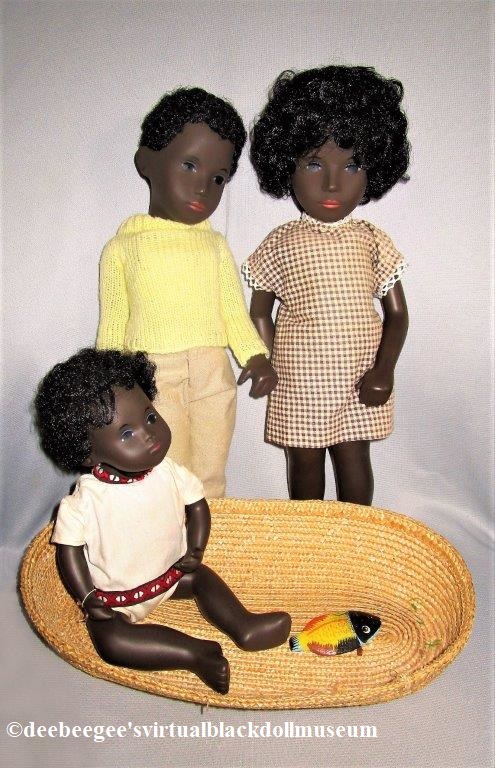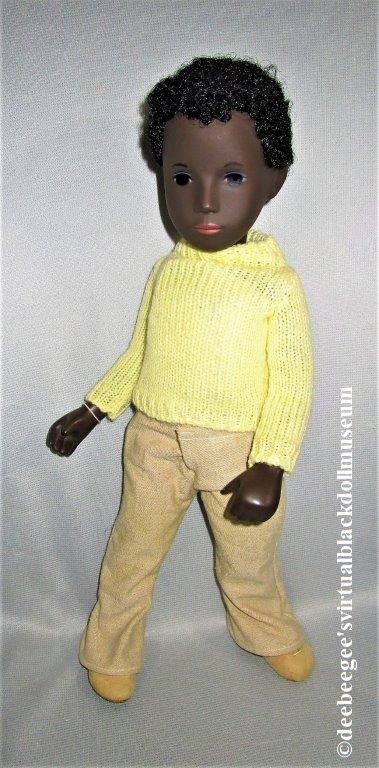Name: Sasha Dolls: Black baby girl (a.k.a. Cara*), Caleb #318, and Cora #118
Made by and When: Trendon Toys of Stockport England for Sasha Morgenthaler, 1970
Material: Rigid string-jointed vinyl
Marks: Sasha Serie Made in England wrist tags are their only identifiers; their bodies are unmarked.
Height: Cara is 12 inches; her Moses basket measures 13 x 7 inches; Caleb and Cora are 16 inches.
Hair, Eyes, Mouth: All have rooted black curly hair; dark brown, almost black painted eyes, and closed mouths with pensive expressions.
Clothes: All original except where stated—baby Cara wears a white top, white diaper, and white short pants. The top is trimmed in red, black, and white brocade. Caleb wears a yellow wool sweater, white knit underpants, tan trousers, white socks, and tan suede lace-up shoes. Worn with replaced white leather shoes, Cora’s brown and white gingham dress is trimmed with white lace at the neck and sleeves. She wears matching panties, the top of which is trimmed with brown rickrack.
Accessories: Include baby Cara’s Moses basket and a papier-mâché fish. (The fish accompanied the doll at purchase; it is unknown if it was manufactured for the doll).
Other: *On page 70 of Sasha Dolls the History by Ann Votaw, Cara is identified as “Black baby girl.” The name Cara is not referenced in this publication. Perhaps collectors felt this doll needed a name that did not reference its skin color and chose the name Cara. Baby Cara is anatomically correct. Caleb and Cora are not. These dolls are examples of Sasha Morgenthaler’s unmarked, England-made Trendon Toys Black dolls. Dolls with their complexions (ebony) were discontinued during the 1980s as described in the text below, which is an excerpt from the curator’s article, “Sasha Morgenthaler’s Dolls for Everyone” published in the January & February 2010 issue of Doll Castle News, pages 28-30.
Sasha Morgenthaler (1893-1975) was a Swiss artist who began making one-of-a-kind (OOAK) dolls in the 1940s after having initially utilized her artistic skills to sew stuffed animals and dolls of cloth in the 1920s for her children. Later, her expertise in sculpting shop window mannequins in the 1930s certainly aided in the fine detail required to sculpt OOAK dolls of gypsum (a heavy, composition-like material), dolls of gypsum and cloth, and plastic dolls. These dolls, also referred to as studio dolls, usually stand 20 inches and are unmarked. Reflective of the world’s children, Morgenthaler’s dolls are reminiscent of the diverse people she encountered during her travels.
Before creating OOAKs, Sasha was initially inspired to sculpt dolls as toys for her own children because she was not happy with conventional dolls. She desired dolls that conveyed realism, without perpetual smiles, because life is not always happy. The OOAK nature of the studio dolls rendered them quite expensive, only accessible to the wealthy and to collectors. Morgenthaler, a humanitarian with a fondness for all people, sought to make her dolls available for everyone—mothers and their children. Consequently, Götz of Germany was licensed to produce her dolls in vinyl. The OOAKs were used to fashion dolls for the commercial market.
Götz manufactured affordable dolls named for their creator from 1964-1970 and then from 1995-2001. The English company, Trendon Toys of Stockport, England, was licensed to manufacture Sasha dolls from 1965-1986. Like the studio dolls, those produced by Trendon are unmarked. The larger dolls produced by Götz have the Sasha Serie logo on their backs and heads. The German-made babies’ heads are not marked, but their backs bear the Sasha Serie logo. All manufactured Sashas came with wrist tags that bear the Sasha Serie logo.
Unless produced in a limited edition and wigged, the manufactured dolls have rooted hair. Their hand-painted, expressive features illustrate individual character. The larger dolls stand 16 to 17 inches while the babies are 12 inches. With their various poses and pensive facial expressions, Sasha dolls possess a true measure of realism. They successfully capture the innocence of childhood, representing the age group of babies to 10-year-old children. Their clothing is always quite simple, which was Sasha’s desire, devoid of frills, fancy fabrics, and trimmings.
Sasha wanted children to utilize her dolls to convey their many emotions. This was a successful accomplishment as the commercially produced Sasha dolls are all vinyl, string jointed, with asymmetrical limbs. The asymmetry (uneven limbs, like humans) allows the dolls to support their own weight and assume various positions as though capturing moments in time without the use of doll stands. The intent was for the child to pose the doll to mimic its various moods.
In addition to their reasonable price, the manufactured dolls, like the studio dolls, also represent children of the world. Non-black parents desiring to introduce their children to other ethnicities did not hesitate to purchase the early commercial line of black Sasha dolls made in England. These dolls from the Trendon era of manufacture include Cora, Caleb, and baby Cara. Their complexion is very dark, as were most England-made dolls. The early black Sashas were more popular in Europe than in the United States, however, where the deep coloring was not widely accepted. According to Susanna Lewis [co-author of Sasha Dolls: The History, 2011], “The black dolls were made only in the English manufacture, never in the German. The black family was introduced in 1972 and [was] given very dark skin coloring. This was changed in 1980 to a lighter skin coloring and continued this way to the end of the production…”
A proportionate few 16-to-17-inch dolls and 12-inch babies have medium complexions comparable to the complexions of African American, Hispanic, Native Alaskan, and Native American peoples. So while Germany ceased producing the darkest dolls (Cora, Caleb, and baby Cara), some of the German-made dolls maintain beautiful caramel brown complexions and even some of the Trendon-made dolls have in-between complexions (not fair and not very dark)…
Today, the German-made dolls by Götz are more plentiful than the Trendon-made dolls, with prices that reflect the British-made dolls’ rarity. Fewer black dolls were made (Cora, Caleb, and baby Cara) and because their production ceased with Götz, these and the other Trendon-made dolls command the highest prices in today’s market.
Even though production of the commercial dolls ceased in 2001, Sasha dolls maintain a huge collector following. There is an annual Sasha festival where Sasha doll enthusiasts gather to celebrate their passion for these delightful dolls. Several websites devoted to Sasha dolls offer a wealth of information and tips on collecting. Online bloggers share their passion in frequent Sasha blog entries. The Sasha Morgenthaler Puppenmuseum (doll museum), located in Zurich, Switzerland, preserves and displays Sasha’s one-of-a-kind studio original dolls, many of which are included in the beautifully written and illustrated hardcover book, Sasha-Puppen Sasha Dolls by Sasha Morgenthaler, edited by Stefan Biffige, 1999. The book offers text in German and English and includes over 100 color and 30 black and white photographs of Morgenthaler’s dolls that represent a diversity of cultures.
Sasha Morgenthaler’s doll children continue to fulfill her intentions. They awaken “affection, love, and comradeship,” (Biffage) and almost every doll lover finds Sasha dolls appealing.
Resources:
http://www.sashadoll.com/
Sasha Dolls the History by Anne Votaw with Ann Louise Chandler and Susanna E. Lewis
Sasha Morgenthaler Estate
Sasha-Puppen Sasha Dolls by Sasha Morgenthaler, edited by Stefan Biffige (Benteli Hallwag Druck AG, Wabern-Bern, 1999)
Gallery








_________
Your comments are valued. Donations aid the initiative to preserve Black-doll history.
If you subscribe to DeeBeeGee’s Virtual Black Doll Museum™ by email, be sure to click the post title in the email, which links to the website to view all text and associated media. Please “like” and share this installation with your social media doll contacts. To subscribe, add your email address to the subscribe or sign-up field in the footer or right sidebar.
Thanks for all the valuable information. I just got my first Sasha doll a couple weeks ago and didn’t know all this about their history.
LikeLike
Congrats on acquiring your first Sasha doll and for sharing that this installation was helpful to you!
LikeLike